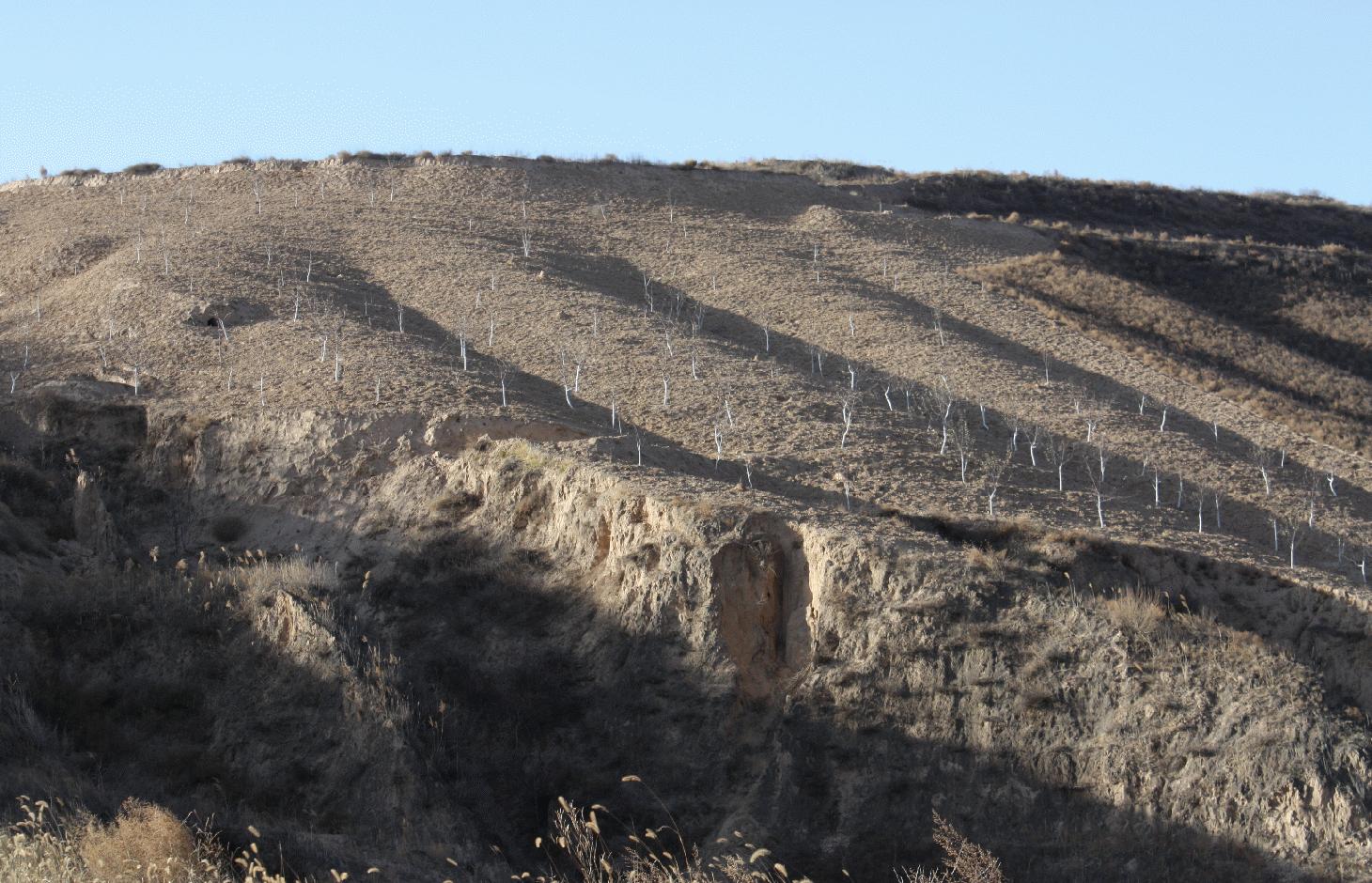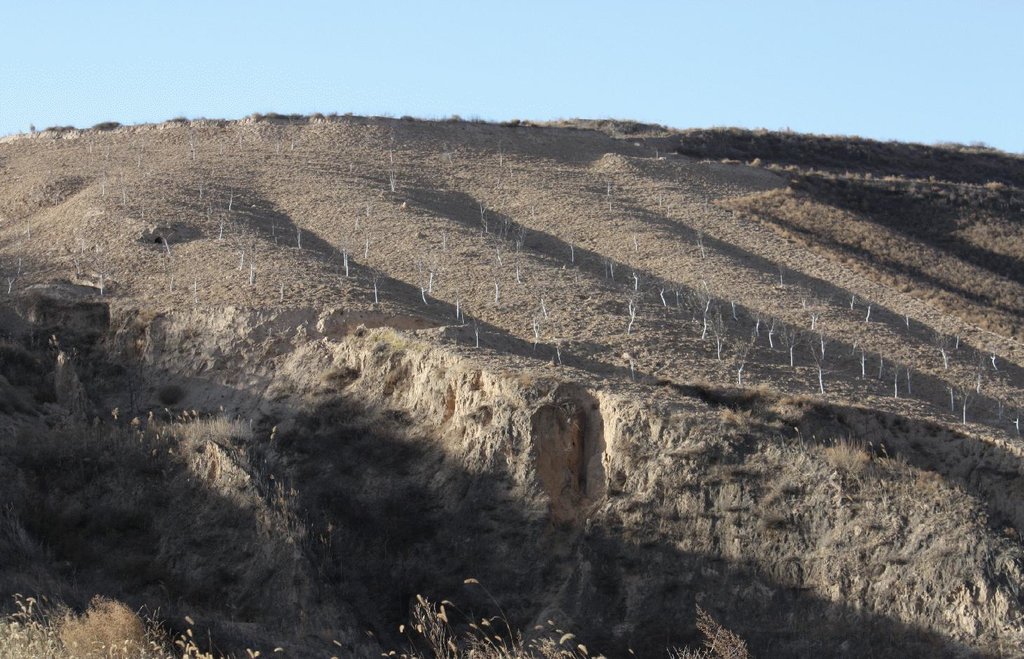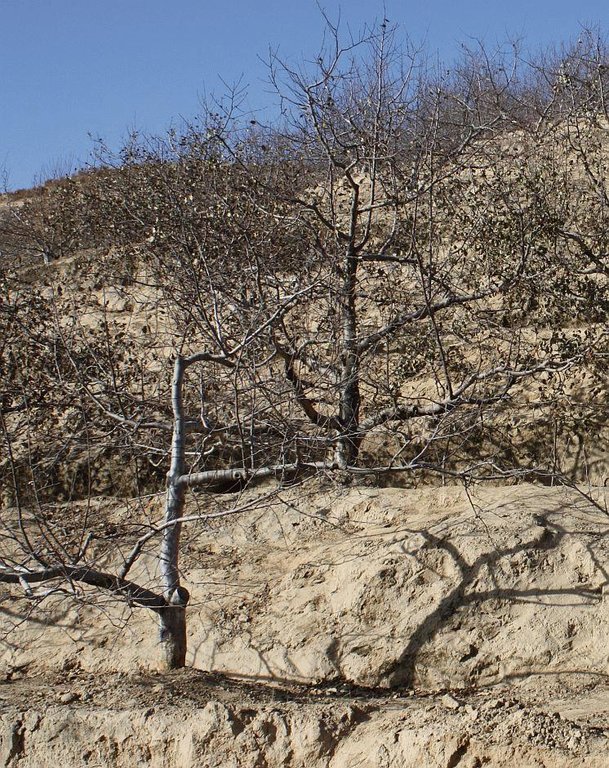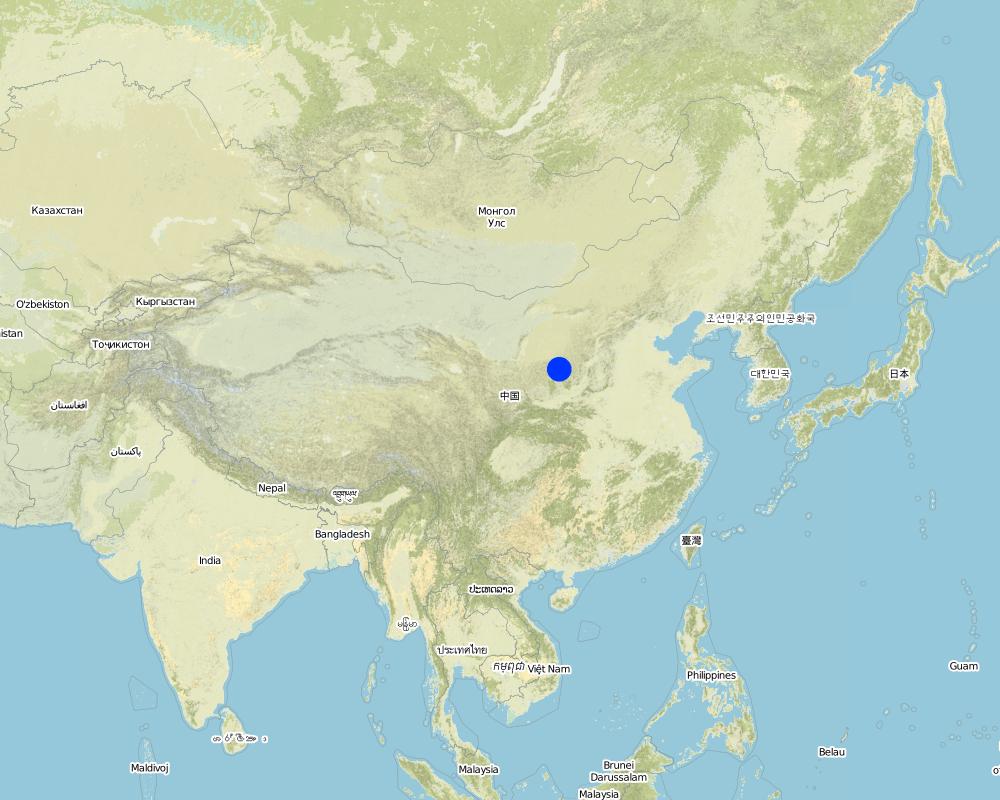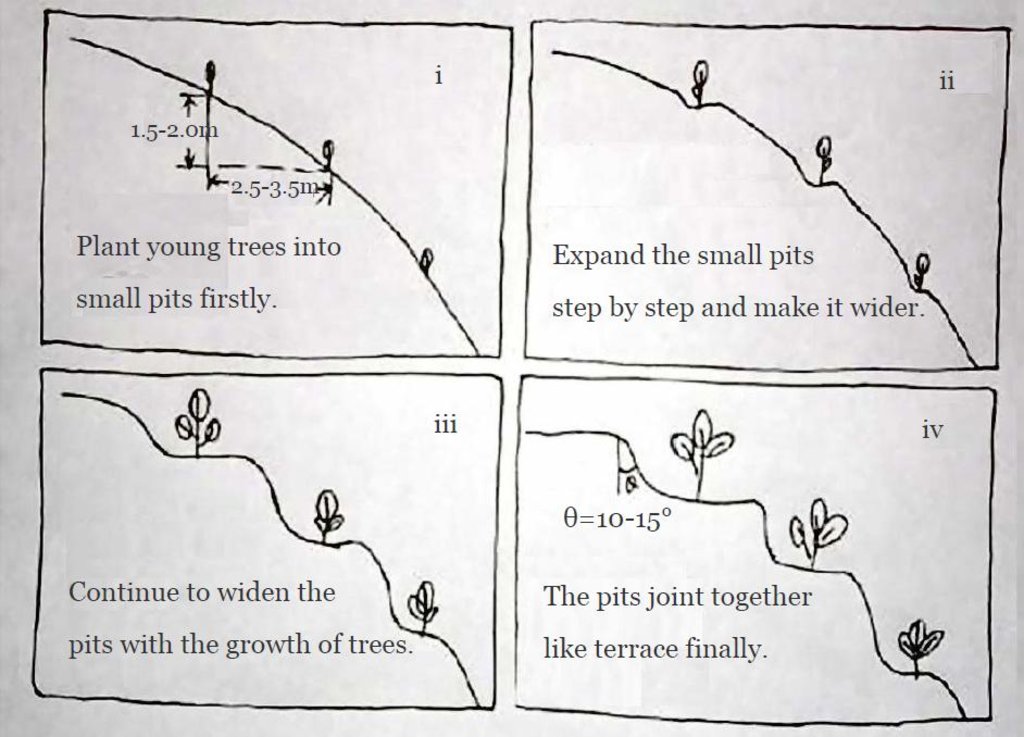Progressive bench terrace [中国]
- 创建:
- 更新:
- 编制者: Fei WANG
- 编辑者: –
- 审查者: Deborah Niggli
树盘,逐年扩盘
technologies_1522 - 中国
查看章节
全部展开 全部收起1. 一般信息
1.2 参与该技术评估和文件编制的资源人员和机构的联系方式
SLM专业人员:
Chen Yunming
Institute of Soil and Water Conservation, CAS and MWR
中国
SLM专业人员:
Liu Guobin
Institute of Soil and Water Conservation, CAS and MWR
中国
SLM专业人员:
Cao Qingyu
中国
有助于对技术进行记录/评估的项目名称(如相关)
DESIRE (EU-DES!RE)有助于对技术进行记录/评估的机构名称(如相关)
Northwest A&F University (NWAFU) - 中国1.3 关于使用通过WOCAT记录的数据的条件
(现场)数据是什么时候汇编的?:
14/06/2011
编制者和关键资源人员接受有关使用通过WOCAT记录数据的条件。:
是
2. SLM技术的说明
2.1 技术简介
技术定义:
Bench terraces are progressively expanded to form a fully developed terrace system in order to reduce runoff and soil erosion on medium- to high- angled loess slopes.
2.2 技术的详细说明
说明:
n Miaowan Village, the technology is mainly applied to apple tree plantations. Tree seedlings are planted in rows every 4 m along the contour with a spacing of 2.5-3.5 m between rows. Trees are planted in pits 40 cm diameter and 3040 cm deep. Manure and/or fertilizer are applied and the seedlings are watered.
Around each tree, soil from the upper parts of the slope is removed and deposited below in order to extend the flat terrain. Over 5-10 years, the terraces become enlarged around each tree and form a terrace with the neighbouring trees along the contour, such that the slopes are transformed into level bench terraces. The fruit trees are located in the middle of the terrace. All the work is done manually using shovels.
Purpose of the Technology: The main purpose of this technology is to reduce runoff and soil erosion on the slope and to improve soil quality and soil moisture retention. It is a sustainable land use technology for small farmers because farmers can use their spare time to improve the land’s condition during the growth of the trees.
A major aim is to conserve water and reduce runoff. Soil erosion in this village is very severe and the soil erosion rate before amounted to 60-100 tonnes per hectare per year and was reduced practically to zero as a result of building the terraces. Slope gradients are very steep (around 20-35 degrees). The main income of local farmers is from orchards.
Establishment / maintenance activities and inputs: The establishment phase thus takes 5-10 years. Afterwards maintenance inputs are restricted to repairing the terrace walls.
2.3 技术照片
2.5 已应用该技术的、本评估所涵盖的国家/地区/地点
国家:
中国
区域/州/省:
Shaanxi
有关地点的进一步说明:
Miaowan Village, Xuejiagou Watershed
注释:
Boundary points of the Technology area: The technology is around the village.
Map
×2.6 实施日期
如果不知道确切的年份,请说明大概的日期:
- 10-50年前
2.7 技术介绍
详细说明该技术是如何引入的:
- 通过土地使用者的创新
注释(项目类型等):
It is a kind of traditional method.
3. SLM技术的分类
3.1 该技术的主要目的
- 减少、预防、恢复土地退化
3.2 应用该技术的当前土地利用类型

农田
- 一年一作
- 乔木与灌木的种植
主要农作物(经济作物及粮食作物):
Main cash crops: Apple
Main food crop: potatoe
注释:
Major land use problems (compiler’s opinion): On moderate- to high-angled slopes, water loss and soil erosion are very high. Outside the protected canopy of the trees rainsplash impact during heavy storms is very severe. The local farmers clear all the wild grasses and shrubs, such as Korshinsk Peashrub, Artemisia scoparia, Leymus secalinus, Stipa bungeana, Lespedeza davurica etc. to reduce competition with the fruit trees. Consequently, the soil is bare and unprotected
3.3 有关土地利用的更多信息
该技术所应用土地的供水:
- 雨养
具体说明:
Longest growing period in days: 300Longest growing period from month to month: Mar - NovSecond longest growing period in days: 200Second longest growing period from month to month: Apr - Oct
3.4 该技术所属的SLM组
- 横坡措施
3.5 技术传播
注释:
Total area covered by the SLM Technology is 2.55 m2.
The whole area of this watershed is about 7.5 Km^2. There are a lot of orchard, mostly apple, in this watershed. It is one of typical watershed with specially soil erosion problem despite the high plant coverage.
3.6 包含该技术的可持续土地管理措施

结构措施
- S11:其它
注释:
Main measures: structural measures
3.7 该技术强调的主要土地退化类型

土壤水蚀
- Wt:表土流失/地表侵蚀

水质恶化
- Ha:干旱化
注释:
Main type of degradation addressed: Wt: loss of topsoil / surface erosion
Secondary types of degradation addressed: Ha: aridification
Main causes of degradation: Heavy / extreme rainfall (intensity/amounts) (Storm are strong in summer.), other natural causes (avalanches, volcanic eruptions, mud flows, highly susceptible natural resources, extreme topography, etc.) specify (orchards on steep slopes without conservation measures), poverty / wealth (to increase the yield and income of orchard.)
Secondary causes of degradation: deforestation / removal of natural vegetation (incl. forest fires) (There is no natural grass cover here.), droughts (Lack of water for the cash trees)
3.8 防止、减少或恢复土地退化
具体数量名该技术与土地退化有关的目标:
- 防止土地退化
- 减少土地退化
注释:
Main goals: prevention of land degradation
Secondary goals: mitigation / reduction of land degradation
4. 技术规范、实施活动、投入和成本
4.1 该技术的技术图纸
4.2 技术规范/技术图纸说明
i: first year: planting of fruit trees along the contour in small pits
ii: after 3-4 years: a small terrace is built up around each tree (as the tree grows it needs more water, which is collected from the platform around the trees..
iii: after 5-8 years: terraces develop
iv: final stage: fully developed level bench terraces
Owing to the soil properties of loess, there is no need to separate surface and subsoil as there is little difference between them. Therefore, soil can be moved directly from upper to lower parts of the terrace without changing soil fertility.
Location: Miaowan Village, Xuejiagou Watershed. Ansai County, Shaanxi Province, China
Date: 2008-12-20
Technical knowledge required for land users: moderate (It is easy to understand and implement.)
Main technical functions: control of concentrated runoff: retain / trap, reduced soil loss
Secondary technical functions: reduction of slope angle, increase of infiltration
Reshaping surface
Vertical interval between structures (m): 1
Spacing between structures (m): 2.5
Depth of ditches/pits/dams (m): 1..5
Width of ditches/pits/dams (m): 2.5
Length of ditches/pits/dams (m): 100-150
Construction material (earth): Using the earth of the same land.
Slope (which determines the spacing indicated above): 45%
If the original slope has changed as a result of the Technology, the slope today is: 2%
Lateral gradient along the structure: 2%
4.3 有关投入和成本计算的一般信息
具体说明成本计算所用货币:
- 美元
注明雇用劳工的每日平均工资成本:
14.2
4.4 技术建立活动
| 活动 | 措施类型 | 时间 | |
|---|---|---|---|
| 1. | Plant the young trees with small pits. | 结构性的 | Before practice |
| 2. | The soils from the upper parts of the slope is shovelled away and deposited on the lower side of the trees | 结构性的 | |
| 3. | Expand the pits into a large platform year by year. | 结构性的 | |
| 4. | 3.4 years after planning the trees a level platform of 2 to 3 square meters around the trees is build. | 结构性的 | |
| 5. | The platforms increase and the space between trees is change into terrace. | 结构性的 |
4.5 技术建立所需要的费用和投入
| 对投入进行具体说明 | 单位 | 数量 | 单位成本 | 每项投入的总成本 | 土地使用者承担的成本% | |
|---|---|---|---|---|---|---|
| 劳动力 | Planting trees | Person/day | 120.0 | 7.3 | 876.0 | 100.0 |
| 劳动力 | Building pits | Person/day | 750.0 | 7.3 | 5475.0 | 100.0 |
| 技术建立所需总成本 | 6351.0 | |||||
注释:
Duration of establishment phase: 60 month(s)
4.6 维护/经常性活动
| 活动 | 措施类型 | 时间/频率 | |
|---|---|---|---|
| 1. | Repair the bank of year-after-year terraced land | 结构性的 | Annual after it formed |
4.7 维护/经常性活动所需要的费用和投入(每年)
| 对投入进行具体说明 | 单位 | 数量 | 单位成本 | 每项投入的总成本 | 土地使用者承担的成本% | |
|---|---|---|---|---|---|---|
| 劳动力 | Reparing of terraced land | Person/day | 15.0 | 14.6 | 219.0 | 100.0 |
| 技术维护所需总成本 | 219.0 | |||||
注释:
Machinery/ tools: spade and hoe
The costs are calculated assuming a local wage rate of 14.2 US$/day.
4.8 影响成本的最重要因素
描述影响成本的最决定性因素:
Slope is the most important factor. The steeper it is, the higher the cost. Labour was not considered as a cost before, but now it is expensive so that some local farmers do not use this technology.
5. 自然和人文环境
5.1 气候
年降雨量
- < 250毫米
- 251-500毫米
- 501-750毫米
- 751-1,000毫米
- 1,001-1,500毫米
- 1,501-2,000毫米
- 2,001-3,000毫米
- 3,001-4,000毫米
- > 4,000毫米
有关降雨的规范/注释:
The mean annual rainfall in the basin is 515.2 mm in the duration from 1952 to 2000. The rainfall from May to Oct accounts for 446.8 mm, up to 86.7%; and that from Jun to Sep accounts for 367.6 mm
农业气候带
- 半干旱
Thermal climate class: temperate. The accumulating time that temperature above 0 ℃ about 3800 hours, and that above 10 ℃ is more than 3200 hours
It is based on the classification sysytem only based on the rainfall
5.2 地形
平均坡度:
- 水平(0-2%)
- 缓降(3-5%)
- 平缓(6-10%)
- 滚坡(11-15%)
- 崎岖(16-30%)
- 陡峭(31-60%)
- 非常陡峭(>60%)
地形:
- 高原/平原
- 山脊
- 山坡
- 山地斜坡
- 麓坡
- 谷底
垂直分布带:
- 0-100 m a.s.l.
- 101-500 m a.s.l.
- 501-1,000 m a.s.l.
- 1,001-1,500 m a.s.l.
- 1,501-2,000 m a.s.l.
- 2,001-2,500 m a.s.l.
- 2,501-3,000 m a.s.l.
- 3,001-4,000 m a.s.l.
- > 4,000 m a.s.l.
说明该技术是否专门应用于:
- 不相关
关于地形的注释和进一步规范:
Altitudinal zone 501-1,000 m a.s.l.: Most area is in this altitudinal zonation
Landforms: Based on 1:100 thousand scale landform map
Slopes on average: Based on 1:100 thousand scale landform map
5.3 土壤
平均土层深度:
- 非常浅(0-20厘米)
- 浅(21-50厘米)
- 中等深度(51-80厘米)
- 深(81-120厘米)
- 非常深(> 120厘米)
土壤质地(表土):
- 中粒(壤土、粉土)
表土有机质:
- 低(<1%)
如有可能,附上完整的土壤描述或具体说明可用的信息,例如土壤类型、土壤酸碱度、阳离子交换能力、氮、盐度等。:
Soil depth on average: The depth of Loess varies from nearly 30 m to more than 100 m in Yanhe River Basin. The depth of soil is less than this but it could be nearly 10 meters in common
Soil texture (topsoil): Here are more than 50% soil particle are fine sand with size between 0.05 and 0.1 mm
Soil fertility very low: Lack of N, P and SOM
Topsoil organic matter: <0.5%
Soil drainage / infiltration good: The inflitration of Loess is very fast, but it is prone to sealing when flashing.
Soil water storage capacity low: It is easy to evaporation and drainage
5.4 水资源可用性和质量
地下水位表:
5-50米
地表水的可用性:
中等
水质(未处理):
良好饮用水
关于水质和水量的注释和进一步规范:
Availability of surface also poor/ none: Nearly all the branches of Yanhe are seasonal river
Availability of surface water medium: It is very stable in this region
Water quality (untreated): Good quality for there are few pollution sources
5.5 生物多样性
物种多样性:
- 中等
关于生物多样性的注释和进一步规范:
It is very stable in this region
5.6 应用该技术的土地使用者的特征
生产系统的市场定位:
- 商业/市场
非农收入:
- 收入的10-50%
相对财富水平:
- 丰富
个人或集体:
- 个人/家庭
机械化水平:
- 手工作业
性别:
- 女人
- 男人
说明土地使用者的其他有关特征:
Land users applying the Technology are mainly common / average land users
Difference in the involvement of women and men: No clear difference.
Population density: 50-100 persons/km2
Annual population growth: < 0.5%
30% of the land users are rich and own 30% of the land (Higher yield and income.).
Off-farm income specification: Only a few land users have implemented this measure because there are other market based activities that bring higher returns. Sometimes farmers have enough money to buy more fertilizer for the orchard.
Level of mechanization: nearly all the work is done by hand.
Market orientation of production system: It is on apple production base and this generates good income of local farmers
5.7 应用该技术的土地使用者拥有或租用的平均土地面积
- < 0.5 公顷
- 0.5-1 公顷
- 1-2 公顷
- 2-5公顷
- 5-15公顷
- 15-50公顷
- 50-100公顷
- 100-500公顷
- 500-1,000公顷
- 1,000-10,000公顷
- > 10,000公顷
这被认为是小规模、中规模还是大规模的(参照当地实际情况)?:
- 小规模的
注释:
0.054 ha per capita
5.8 土地所有权、土地使用权和水使用权
土地所有权:
- 州
- 社区/村庄
土地使用权:
- 个人
用水权:
- 自由进入(无组织)
5.9 进入服务和基础设施的通道
健康:
- 贫瘠
- 适度的
- 好
教育:
- 贫瘠
- 适度的
- 好
就业(例如非农):
- 贫瘠
- 适度的
- 好
道路和交通:
- 贫瘠
- 适度的
- 好
饮用水和卫生设施:
- 贫瘠
- 适度的
- 好
金融服务:
- 贫瘠
- 适度的
- 好
6. 影响和结论性说明
6.1 该技术的现场影响
社会经济效应
生产
作物生产
SLM之前的数量:
45000kg
SLM之后的数量:
52500kg
注释/具体说明:
Yield increasing by 16.7%
收入和成本
农业收入
SLM之前的数量:
9883
SLM之后的数量:
11530
注释/具体说明:
Income increases by 1647 USD per ha.
工作量
SLM之前的数量:
1500
SLM之后的数量:
1650
注释/具体说明:
10% person days increases annually in the first 5 years
社会文化影响
社会经济弱势群体的情况
SLM之前的数量:
2700
SLM之后的数量:
3200
注释/具体说明:
Not excluding of the labour input of the local farmers themselves.
Livelihoods and human well-being
生态影响
水循环/径流
地表径流
SLM之前的数量:
60 mm/yr
SLM之后的数量:
<10 mm/yr
注释/具体说明:
no runoff in common
土壤
土壤流失
SLM之前的数量:
60 t/yr/ha
SLM之后的数量:
10 t/yr/ha
注释/具体说明:
Soil erosion is well controlled
6.2 该技术的场外影响已经显现
旱季稳定可靠的水流
SLM之前的数量:
60mm/yr
SLM之后的数量:
<10mm/yr
下游洪水
SLM之前的数量:
60 mm/yr
SLM之后的数量:
<10 mm/yr
6.3 技术对渐变气候以及与气候相关的极端情况/灾害的暴露和敏感性(土地使用者认为的极端情况/灾害)
渐变气候
渐变气候
| 季节 | 气候变化/极端天气的类型 | 该技术是如何应对的? | |
|---|---|---|---|
| 年温度 | 增加 | 好 |
气候有关的极端情况(灾害)
气象灾害
| 该技术是如何应对的? | |
|---|---|
| 局地暴雨 | 好 |
| 局地风暴 | 不好 |
气候灾害
| 该技术是如何应对的? | |
|---|---|
| 干旱 | 好 |
水文灾害
| 该技术是如何应对的? | |
|---|---|
| 比较和缓的(河道)洪水 | 未知 |
其他气候相关的后果
其他气候相关的后果
| 该技术是如何应对的? | |
|---|---|
| 缩短生长期 | 未知 |
注释:
The technology increases infiltration, reduces soil erosion by water and improves soil moisture retention to reduce the negative impact of extreme drought. However, it does not protect the soil well from wind erosion. Soil cover could be increased to protect against strong winds and reduce
6.4 成本效益分析
技术收益与技术建立成本相比如何(从土地使用者的角度看)?
短期回报:
稍微积极
长期回报:
积极
技术收益与技术维护成本/经常性成本相比如何(从土地使用者的角度看)?
短期回报:
积极
长期回报:
积极
注释:
It is very cheap to maintain this measure. More trees could be planted on degraded land in future.
6.5 技术采用
- 10-50%
如若可行,进行量化(住户数量和/或覆盖面积):
65 households (15percent of the stated area)
在所有采用这项技术的人当中,有多少人是自发地采用该技术,即未获得任何物质奖励/付款?:
- 90-100%
注释:
Comments on acceptance with external material support: There are no outside input to do sunch thing.
100% of land user families have adopted the Technology without any external material support
65 land user families have adopted the Technology without any external material support
Comments on spontaneous adoption: In this area, there are many other practices, such as reforestation, enclosure (to prevent grazing) and terrace construction.
There is a moderate trend towards spontaneous adoption of the Technology
Comments on adoption trend: Even the local farmers know the benefits of progressive bench terraces, but with the increased labour costs, fewer people apply this technology.
6.7 该技术的优点/长处/机会
| 土地使用者眼中的长处/优势/机会 |
|---|
|
Higher yield and income. How can they be sustained / enhanced? If they have time, they wish to adopt this technology. |
| 编制者或其他关键资源人员认为的长处/优势/机会 |
|---|
|
Establishing the technology over a long time. Local farmers have enough time to do it How can they be sustained / enhanced? Show to land users that they have time and can spread to work over many years and fit the labour into the time they have available. |
|
It can reduce water loss and soil erosion and prevent the degradation of land How can they be sustained / enhanced? Give subsidy to the local farmers to reduce the sediment delivery into the downstream river. |
|
It can increase soil moisture. How can they be sustained / enhanced? Makes people understand the importance of conserving water with such a technology. |
|
Higher yield and income. How can they be sustained / enhanced? Share ideas through meeting in the field. Present this measure to more people and show them how to apply it and promote the technology to more farmers. |
6.8 技术的弱点/缺点/风险及其克服方法
| 土地使用者认为的弱点/缺点/风险 | 如何克服它们? |
|---|---|
| It takes a lot of time to establish it. | It is difficult to use it, because the people could balance the establishment costs and work at the labour market. If they can get some subsidy from government, they may adapt this measure. |
| 编制者或其他关键资源人员认为的弱点/缺点/风险 | 如何克服它们? |
|---|---|
| It takes considerable time to establish and labour is more and more expensive so that farmers are looking for paid work | Subsidy for farmers using this measure. |
7. 参考和链接
7.2 参考可用出版物
标题、作者、年份、ISBN:
Soil and water conservation records of Shaanxi Province. 2000. Shaanxi People's Press, Xi'an City, China
可以从哪里获得?成本如何?
Library of ISWC, CAS
链接和模块
全部展开 全部收起链接
无链接
模块
无模块


